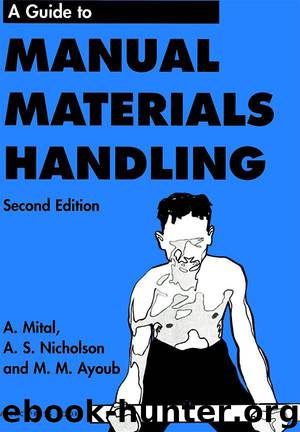Guide to Manual Materials Handling (Guide Book Series) by A. Mital

Author:A. Mital [Mital, A.]
Language: eng
Format: azw3
Publisher: CRC Press
Published: 2017-10-19T04:00:00+00:00
Epidemiological approach
Snook (1978) proclaimed that up to one-third of back injuries can be prevented. In a survey carried out by the Liberty Mutual Insurance Company, it was found that up to one-quarter of the jobs required manual handling of a magnitude acceptable to less than 75% of the workers. These jobs were responsible for half the back injuries reported, thus indicating a three-fold increase in susceptibility when the tasks require such exertion. This implies that two-thirds of all back injuries associated with MMH activities can be prevented if the job is designed to fit at least 75% of the workforce. The survey extrapolated that one-third of the injuries will occur despite any design effort. Counting the injuries which were not associated with heavy manual handling, Snook (1978) calculated an overall possible reduction in low-back injuries by 33% for industrial workers if an appropriate design strategy were to be instituted. Though such claims are hard to substantiate experimentally, it indicates an approximate 33% collective margin of safety for the workforce.
Ayoub et al., (1983) observed a rapid and substantial increase in back problems suffered by male workers as the JSI increased above 1.5. The maximum weight associated with this JSI value was observed to be 27.24 kg. This load provides a spinal compression of 3930 N. When this compression is compared to the mean ultimate spinal compression strength of male spinal elements (5700 N; range approximately 3000-11000 N), provided by Jager and Luttmann (1991), a margin of safety of 31% is obtained. Assuming that females would also show a steep increase in back problems at a JSI value of 1.5, a factor of safety of approximately 31% would provide a spinal compression of 2689 N (mean ultimate compression strength of female spine elements = 3900 N; range approximately 2000-7000 N).
Download
This site does not store any files on its server. We only index and link to content provided by other sites. Please contact the content providers to delete copyright contents if any and email us, we'll remove relevant links or contents immediately.
| Anthropology | Archaeology |
| Philosophy | Politics & Government |
| Social Sciences | Sociology |
| Women's Studies |
The Secret History by Donna Tartt(18846)
The Social Justice Warrior Handbook by Lisa De Pasquale(12141)
Thirteen Reasons Why by Jay Asher(8796)
This Is How You Lose Her by Junot Diaz(6794)
Weapons of Math Destruction by Cathy O'Neil(6146)
Zero to One by Peter Thiel(5686)
Beartown by Fredrik Backman(5599)
The Myth of the Strong Leader by Archie Brown(5425)
The Fire Next Time by James Baldwin(5249)
How Democracies Die by Steven Levitsky & Daniel Ziblatt(5128)
Promise Me, Dad by Joe Biden(5087)
Stone's Rules by Roger Stone(5026)
A Higher Loyalty: Truth, Lies, and Leadership by James Comey(4845)
100 Deadly Skills by Clint Emerson(4840)
Rise and Kill First by Ronen Bergman(4704)
Secrecy World by Jake Bernstein(4646)
The David Icke Guide to the Global Conspiracy (and how to end it) by David Icke(4625)
The Farm by Tom Rob Smith(4437)
The Doomsday Machine by Daniel Ellsberg(4416)
